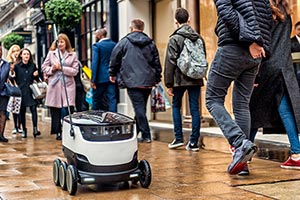Virginia Lawmakers Considering Bill to Allow Delivery Robots on Sidewalks

It looks like a mini-Mars rover and, someday soon, it could be rolling down the sidewalk next to you as you walk to lunch or take your nightly jog.
It’s an “electric personal delivery device,” a bureaucratic-jargon way of saying: “This thing picks up your groceries and delivers them to your door without any human help.”
It has six wheels, and some have described it as a “clean, shiny version of an Igloo cooler.”
It’s a fairly new technology that’s seen as an alternative to aerial drone delivery.
But there’s no law on the books to allow them to use sidewalks in Virginia.
RELATED: Autonomous Starship robot makes first delivery in San Francisco
A proposed one, HB 2016, would allow these devices on sidewalks, shared-use paths and crosswalks in the commonwealth unless otherwise prohibited by a locality. It also exempts the vehicles from motor carrier provisions. The bill, patroned by Del. Ron Villanueva of Virginia Beach, has not been assigned to a committee.
Starship Technologies, a London-based company, has tested 75 autonomous-delivery rovers in London, Germany and Switzerland. The company’s bots have traveled more than 15,000 miles and encountered 3 million people.
Washington is the first pilot city in the United States after it passed similar legislation in 2016, allowing the six-wheeled bots to roam the sidewalks and crosswalks of the city.
RELATED: Robots may beat drones in race to deliver packages
Starting this month, the robots will deliver food, groceries and other packages in 15 to 30 minutes for $1 to $3. The robots partner with existing delivery companies and will be an option at checkout for select merchants.
Employees load the robot’s compartment and it moseys off to its destination at 4 mph or less. It can alert people of its presence through speakers.
Like autonomous vehicles, the robots have cameras, GPS, sensors and other obstacle-detection features so they don’t bump into anything. But there is human oversight that can make decisions if the little robot gets into a pickle.
“The autonomous craze has taken over,” Villanueva said. “Just like Uber’s self-driving cars, these electric personal delivery devices will be a part of our future.”
Villanueva said sidewalks are either the most highly utilized or underutilized assets in our cities, depending on the area. Downtown Norfolk and Virginia Beach Town Center sidewalks are busier at lunch. Neighborhoods and sidewalks along arterial roads may be less busy.
“We have an emerging metro with growing dense areas, folks living downtown,” Villanueva said. “It makes sense to have new tech where it makes sense — it brings new business, even a new supply chain.”
Villanueva said he wants the law to be on the books to continue making Virginia a forward-thinking state. He’d love to see Hampton Roads become a new test bed, although the company hasn't announced expansion of the program yet.
Mary Miller, CEO of the Downtown Norfolk Council, said she has a lot more questions than first impressions:
How does it know where people are? Will it know if they're on their phones not paying attention so it doesn’t trip them? Does it behave courteously? Will it be able to navigate tight sidewalks strewn with A-frame signs, sidewalk cafes and construction materials?
She sees it as an interesting idea and one that would appeal to downtown dwellers that already heavily use delivery services such as OrderUp, Granby Street Pizza that delivers via mini-truck, and Jimmy John's that delivers by bike.
Delivery can be a tough thing for full-size vehicles to navigate downtown, she said.
“I see the merit in the idea: delivering food to busy workers or the elderly or disabled,” Miller said. “But I guess the bottom line is how does it work in real life?
“It’s cute! It looks like Wall-E.”
The company is going to demonstrate its product at the General Assembly later this session, Villanueva said.
Autonomous delivery is the latest development in the ever-increasing speed of goods delivery.
It used to be shipping could take seven to 10 days or longer. Then, in 2005, Amazon launched Prime, a two-day shipping service for which users paid an annual fee.
Last year, Amazon launched Prime Now in Hampton Roads, promising select goods delivered to your door in an hour or less.
At Virginia Tech, Google tested near-instant drone delivery of Chipotle Mexican Grill burritos.
Next, it may be a little robot bringing home the bacon.

